Photo: Parking at the US Post Office on Concord Avenue will return to the curb after a vote by the Belmont Select Board on July 10.
The Belmont Select Board made three significant changes to a pair of streets at its Monday, July 10 meeting.
- The direction of Underwood Street is being reversed, soon to run one-way from Hittinger to Concord Avenue.
- Two parking spaces will be constructed near the intersection of Concord and Underwood to accommodate at least one handicapped space for visitors to the Belmont Veterans Memorial.
- On-street parking adjacent to the US Post Office on Concord Avenue will be relocated to the curb, with the bike lane set between traffic and parking.
Underwood turn-around
The reason for changing Underwood from north to southbound is to forestall what Chair Roy Epstein called “an extremely serious, probably unsafe and regrettable degree of congestion” when the new Middle and High School parking lot and Middle School building opens for the new academic year in September.
Epstein pointed out that under the current traffic pattern, the new driveway into the school located at Hittinger and Trowbridge would be a maelstrom of vehicles attempting to arrive and leave from three streets. With Underwood turned around and running north to south, a right-hand turn on Hittinger and left to Underwood will funnel exiting vehicles away from the school and towards Concord Avenue.

“That would achieve a level of separation between inbound and outbound traffic and … distributes the cars better across the streets,” said Epstein. “The main thing is to avoid congestion.”
Daytime parking for Underwood homeowners, residents, and visitors will be on the residential side of the street. The change will require residents to take neighborhood side streets to get home instead of taking a quick right off Concord.
At the meeting, former State Rep. and Select Board member Ann Paulson expressed concerns that sidewalks crossing Concord were “very vital” as many students walk from Precincts 1 and 7 to the school and use the crossings. Epstein said while it “remains a work in progress,” the crosswalks will not be ignored.
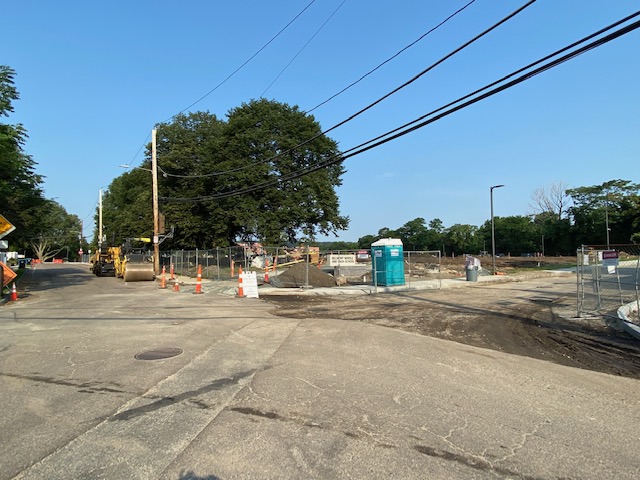
With the Belmont Police and the Office of Community Development signing off on the plan and the Middle and High School Traffic Working Group narrowly approving it, 4-3, the change received the board’s OK.
“It’s a really good idea,” said Board member Mark Paolillo as it voted unanimously to adopt the plan. The turnover will occur sometime in late July/early August.
Finding a doable parking fix for visiting the Vets Memorial
The change in Underwood’s direction also resulted in what Paolillo called “a fair compromise, ” which could have been a nasty fight between interested parties.
The Belmont Veterans Memorial is a shining example of volunteers and residents coming together to create a monument to those who served our country the community can appreciate for years to come. But for the leaders of the Veterans Memorial committee, there is a glaring issue they say can not be ignored: the lack of handicapped parking to allow older and disabled vets to visit the site.
“People aren’t coming to the memorial right now … because it’s just not safe,” said retired US Marine Corp Col. Mike Callahan, chair of the Veterans Memorial Committee.
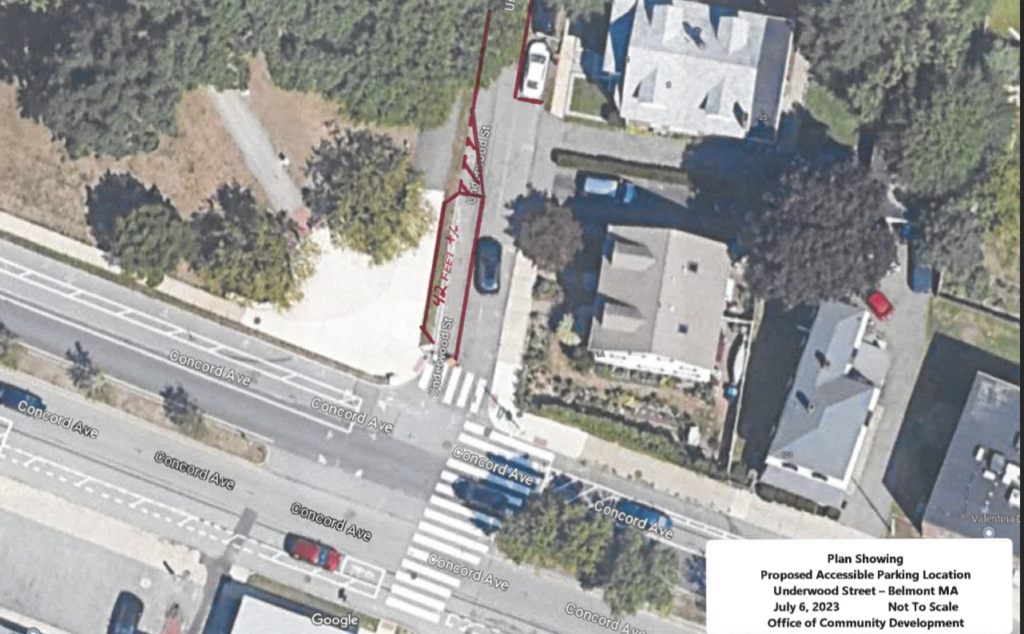
To assist disabled vets, Callahan and the committee requested last month the town create up to three handicapped spaces, two on the west immediately after the Underwood/Concord intersection and one to the east.
Those questioning the request said the debate was not about vets vs. cyclists but about providing safety for bikers. Bike advocates noted their concerns about forcing cyclists to weave out and back in along the roadway. Select Board member Roy Epstein also observed that one handicapped space would lose three or four spaces, which are needed as there is an anticipation of greater demand for student parking on Concord beginning in September.
As noted at the board’s previous meeting in June, a compromise was in the offing with the switch of the direction of Underwood. With the directional change approved on Monday, July 12, the town will carve out two parking spaces on the right-hand side of Underwood by removing about 40 feet of the four-foot grass strip adjacent to the path leading to the school nearest to the intersection. One space would be dedicated handicapped, with the other available for residents or visitors. For holidays and special events or celebrations, both spaces would be reserved for the disabled.

“What I like about having it closest to the curb is you have immediate access to the accessibility ramp to get you up on the sidewalk,” said Glen Clancy, director of the Office of Community Development and Town Engineer, who designed the new spaces. The other advantage of placing the spaces on the pond side is that drivers will naturally slow down with a stop sign at the intersection, which increases safety when the driver exits and brings out a wheelchair.
When the board’s vice chair Elizabeth Dionne said while every group is committed to making the plan a success, “we have at least a workable first draft,” a sentiment Callahan retorted, “I don’t disagree.”
And with a few add-ons to the project, such as a small ramp to the path between the new parking spaces, the vets and town supported the plan with the Select Board OK-ing the added spaces, 3-0.
The post office with curbside service
It took less than 10 minutes for the Select Board to turn back the hands of time and return parking in front of the US Post Office to precisely where it once was.
“We’re putting back [parking spaces] to the way it was, other than the transition point by the post office parking lot,” said Epstein.
But the back story of the unanimous vote demonstrated the difficulty in finding a working solution. From last year, the board was caught between the insistent concerns of seniors and the counterarguments by cyclists that being next to vehicle traffic is not the safest of positions.
Even before the town “painted” Concord Avenue placing the bike lane along the curb for nearly the entire length of the roadway, several residents – a majority made up of the senior community and the elderly – registered complaints that moving vehicle parking off-the-curb presented seniors with “an unsettling feeling” exiting their vehicles close to the traffic, according to Clancy.
“We’ve gotten more complaints on this post office and the unsafe conditions in my mind than any other issue,” said Paolillo.
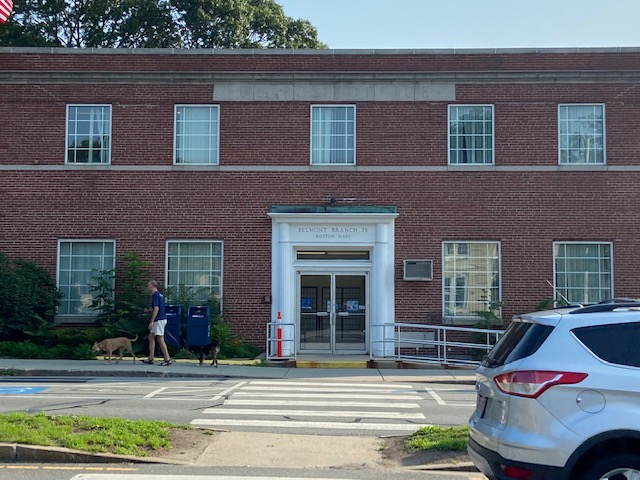
The effort to develop a dedicated lane is to encourage students to bike to the new Belmont Middle and High School. The past configuration with the bike lane between traffic and parked cars deterred many potential bikers – especially youngsters – from cycling to school.
“For the last three years as the high school has been built, we’re talked and talked and talked about making this town safe for biking,” said Paulsen, School Street resident, and former state representative and select board member, who was the only bike advocate to show up in person at the June meeting.
In addition to parking, the residents pointed to the limited visibility pedestrians have seeing oncoming traffic as parked cars and SUVs block their view, requiring them to step into the busy bike lane to be seen.
Yet bikers pointed out the danger of riding alongside vehicles and the threat of being “doored” – when drivers fling open their driver-side doors. Aaron Pikcilingis, Town Meeting member Precinct 6, recounted being doored twice in streets with the same layout as proposed at the post office.
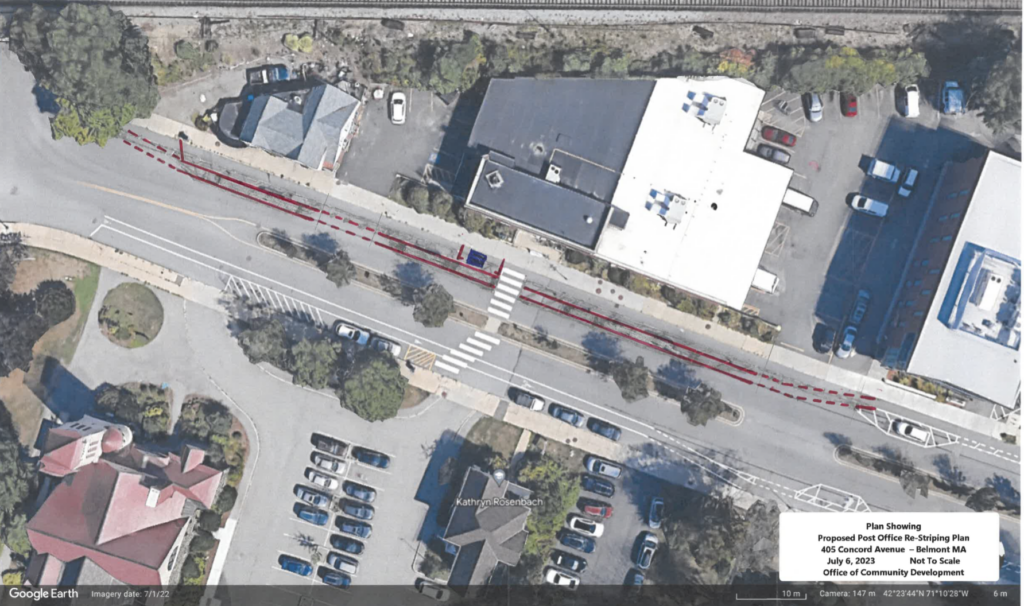
“I was lucky that collision did not throw me off my bike to the left … and being sent into traffic. I have been by many ghost bikes where many people died,” said Piccilingis. “So the configuration … is dangerous for cyclists as they are used as a buffer to protect people getting out of their cars,” said Pikcilingis.
In response to the board’s earlier request, David Coleman presented at the board’s June 26 meeting three possible street calming elements approved by the Traffic Advisory Committee he chairs that would increase pedestrian safety at the post office: permanent bollards to prevent vehicles from limiting the sight lines at the crosswalk, street decals warning bicyclists to reduce speeds as they approach the postal facility, and the introduction of a speed bump just before the first parking spaces to bring down speeds.
But TAC’s requests received pointed pushback but not from older drivers. Rather, it was the leaders of the town departments who challenged the recommendation. While the estimate for the three requests comes to at most $4,000, it is another bill the town will need to pay ad hoc as each issue arises.
“[The requests] just keep ticking up and up and up,” said Belmont Town Administrator Garvin. “And we have no budget for this.”
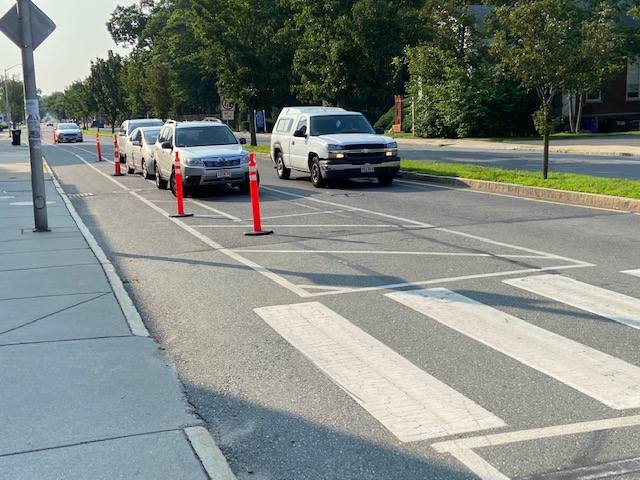
And it was not just the lack of funding that had officials concerned. DPW Director Jay Marcotte said the bollards are just another task his already overburdened personnel will need to undertake when it installs barriers and removes them when the town plows the streets during snow storms. Finally, Clancy said it’s uncertain that traffic calming is needed at the post office as there is no evidence drivers are speeding along that length to Concord, nullifying the need for a speed bump.
Rather than a piecemeal approach, which she doesn’t see as productive, Garvin said a comprehensive traffic and bike safety plan was needed, including finding a dedicated funding source.
“We really need to consider our spending priorities and not just when people come to the TAC … then we start spending money,” said Garvin. “It’s not a good use of the town funds.”
For the board, Epstein has long contended “it is not a significant safety hazard [for vehicles to] go back to the curb,” pointing to the relative safety between bikers and vehicles on Trapelo Road, which, he believes, is just as busy a corridor as Concord.
With the mounting concerns from the town departments and the complaints from older postal patrons, Paolillo said a decision had to be made to return the parking curbside. He also said the board would pitch having the speed limit on that short stretch of Concord reduced to 10 mph from the current 25 mph.
“This is a balance, and no one’s happy,” said Paolillo, at the June meeting.







Leave a Review or Comment